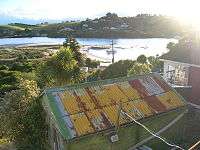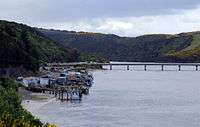Taieri Mouth
Taieri Mouth is a small fishing village at the mouth of the Taieri River, New Zealand. Taieri Island lies in the ocean several hundred metres off the river's mouth.

It has a white sand beach for swimming and several picnic areas. Moturata Island is a distinctive landmark which can be walked to at low-tide. Caution is advised as the tides can change quickly. Another feature is the millennium walking track that follows the Taieri River from the mouth through the lower gorge to Henley.
The village is located 40 km southwest of central Dunedin on the Southern Scenic Route. It is located in the Clutha District on the boundary of Dunedin City and 10 km east of Lake Waihola.
It gained a little notoriety or sadness in the 1990s as the place where the father of murder suspect David Bain worked.
History

There was a Māori occupation site at Taieri Mouth, with moa bones, indicating it was from the Moa Hunter (Archaic) period of Māori culture.
According to oral tradition in the early 18th century Tuwiriroa moved from Tititea on the Kawarau River near modern Queenstown and built a pa, Motupara, near Taieri Mouth. A rival, Tukiauau, had already built a pa, Whakaraupuka, inland on the Taieri Plain by Lake Waihola. Tuwiriroa had a daughter Haki Te Kura, famous for swimming across Lake Wakatipu. Tukiauau had a handsome son Korokiwhiti. The daughter and son now fell in love but the woman's father, the chief of the Taieri Mouth pa, disapproved. The young man's father was a hunted man. Hearing his enemies had discovered his whereabouts he decided to abandon the upriver settlement and move his people further south. As they came down the river in their canoes the distraught young woman attempted to jump from a rock into her lover's craft but struck the prow and was killed. Adding insult to injury her head was severed and held up angrily to her people on the shore as the flotilla passed by to the sea. There were repercussions and Tukiauau and his son were pursued and eventually killed.[1]

Maori occupation continued and Edward Shortland recorded a small settlement on the site in 1843 and Maori were still living here in 1850.[2] An early European settler was a former whaler, 'The Hermit of Taieri Mouth' (also known as John Bull) whose real name was John Edward O'Neil. He is remembered for his boisterous ways and prodigious strength.[3]
Education
Taieri Beach School is a co-educational state primary school for Year 1 to 8 students,[4] with a roll of 4 as of March 2020.[5]
References
- Anderson, A (1998) The welcome of strangers. Dunedin: University of Otago Press ISBN 1-877133-41-8
- Shortland, E., (1851) The southern districts of New Zealand: A journal. London: Longman, Brown, Green & Longmans
- "Taieri Mouth and Taieri Beach", from The cyclopedia of New Zealand (Otago and Southland Provincial Districts). Retrieved 4 August 2013.
- "Taieri Beach School Ministry of Education School Profile". educationcounts.govt.nz. Ministry of Education.
- "Taieri Beach School Education Review Office Report". ero.govt.nz. Education Review Office.
- Parkes, W., and Hislop, K. (1980) Taieri Mouth and its surrounding districts. Dunedin: Otago Heritage Books. ISBN 978-0-908774-40-1